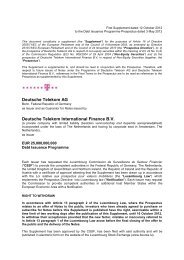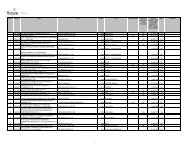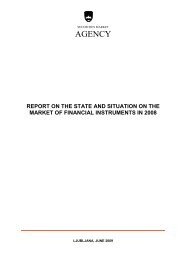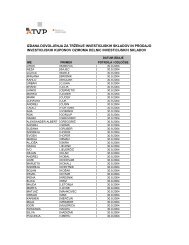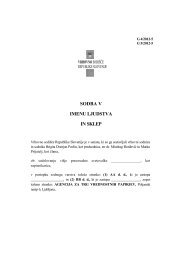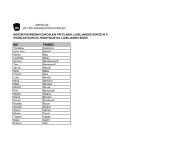oadband cable television connections. This is in addition to a small number of connections thatutilise other fixed-network technologies, such as fiber-optics. Deutsche Telekom believes there wereapproximately 27.1 million fixed-network broadband connections in Germany at the end of 2011, anincrease of around 5% compared to 2010.Service revenues in the German mobile telephony market remained nearly stable compared to 2010,despite lowered termination charges. Revenue from text messaging and data services was thegreatest driver, due to the growing popularity of smartphones and tablet PCs, which nearlycompensated for the decline in conventional mobile telephony. This is the reason why some mobilecommunications providers are placing greater emphasis on customer loyalty and value-driven growthamong contract customers by offering complete packages. Moreover, Deutsche Telekom is alsoseeing growth in new services and application, such as iMessage and MobileTV.Nearly one in three Internet users in Germany accesses the Internet using a mobile device, andmobile access to online communities, location-based services and shopping is growing rapidly.Deutsche Telekom expects the mobile payment business to continue to grow as a result.According to the Federal Network Agency, German network operators invested more than EUR 93billion in telecommunications networks between 1998 and 2010, and nearly EUR 6 billion in 2011alone. Broadband connections with speeds of at least 1 Mbit/s are now available to nearly 99% ofhouseholds in Germany. The remaining coverage gaps are provided with high-speed Internet throughwireless technologies. The German government and network operators intend to make connectionswith transmission rates of at least 50 Mbit/s available to 75% of households by 2014.To facilitate this expansion, some of Deutsche Telekom's competitors are upgrading their LTEinfrastructure. Deutsche Telekom is building on a mix of technologies, comprising mobiletelecommunications, fiber-optics and copper-based connections in the fixed-network. Currently,Deutsche Telekom has equipped its mobile network in Germany with the powerful HSPA plustechnology and can now offer customers transmission speeds of up to 42 Mbit/s. While DeutscheTelekom is initially deploying the 800 MHz frequency band to supply broadband LTE to rural areas,frequencies in the 1,800 MHz range will be used in metropolitan areas. This increases thetransmission capacity for the rapidly rising volume of data traffic and will enable even highertransmission speeds.EuropeIn 2011, the telecommunications markets in the countries of Deutsche Telekom's Europe operatingsegment were characterised by intense competition, continuously falling retail prices and stronggovernment and regulatory impact. In particular, the reductions in termination rates, some of whichwere substantial, presented the companies operating in these markets with considerable challenges.Falling prices, the result of regulatory intervention, major competitive pressure, and in some casesweak purchasing power, caused the size of telecommunications markets in almost three quarters ofthe countries in this operating segment to either contract or stagnate.The telecommunications markets (measured by revenues) in the Czech Republic, Albania, andRomania all experienced a contraction. In addition, the situation was particularly severe in Greece,where telecommunications revenues dropped around 8% compared with 2010. The debt crisis and theGreek government's strict austerity program translated into lower consumption and, in turn, lowerspending on telecommunications. Poland experienced market growth of approximately 3%. Incontrast, telecommunications markets in Austria and the Netherlands remained stable or experiencedslight growth.In the fixed-network segment, trends from 2010 continued. Significant growth in the broadbandbusiness compensated for some of the decline in revenue from voice telephony. Broadband coveragevaries among the countries included in Deutsche Telekom's Europe operating segment. Faced withincreasing demand for greater bandwidths, both cable network operators and telecommunicationsproviders are investing in upgrading their broadband networks, resulting in increasing competition.Fiber-optics play a crucial role in upgrading broadband networks and Deutsche Telekom is investing inthe construction of a pure-fiber network in certain of the countries in the Europe operative segment.To meet the rising demand for fast data transfer, Deutsche Telekom is modernising and upgrading itsmobile networks by equipping them with faster HSPA plus technology and implementing the newmobile communications standard LTE. In Austria, for example, LTE was implemented in December52
2010. The demand for ever-faster data transmission rates also requires further measures in the areaof mobile communications frequencies. In 2011, some countries held auctions, in which DeutscheTelekom participated, to extend existing licenses and distribute additional frequency bands.Telecommunications providers that offer both mobile and fixed-network communications areincreasingly consolidating their services for mobile, broadband/TV and fixed network into triple-play(includes high-speed Internet access, communication services and entertainment offerings) and evenquadruple-play offers. Moreover, many services are converging. For example, television can now bewatched on a television set, computer or smartphone. Television accounts for a larger proportion ofthe business in the markets in the Europe operating segment and Deutsche Telekom's televisionservices are available through IPTV, cable and, in some countries, through satellite.United StatesIn 2011, the slow growth of the U.S. mobile telecommunications market continued. Once again,increasing data revenue more than compensated for declining voice revenue. The market is dividedamong four national cellular providers, AT&T Wireless, Verizon Wireless, Sprint and T-Mobile USA,and various regional network operators. There are also a number of mobile virtual network operators,which use the networks of one or more of the four national cellular providers. The two largestproviders, AT&T Wireless and Verizon Wireless, achieved strong revenue growth and healthy marginsin 2011. This was primarily driven by strong growth in smartphone adoption and rising postpaidaverage revenue per user. Due to advantages of size, scale and their ability to bundle wireless servicewith other non-wireless communication services, AT&T Wireless and Verizon Wireless were able tooffer cheaper service and increase their customer base.AT&T has had a competitive advantage in the past three years as a result of its exclusive distributionrights for the Apple iPhone that expired in 2011. Verizon and Sprint became additional distributors ofthe Apple iPhone, gaining a competitive advantage as well. Verizon and AT&T were able to increasetheir net customer gain disproportionately during 2011. Increased competition from low-cost regionalfull-service providers also put downward pressure on prices. These effects resulted in a decline inmarket share for T-Mobile USA. Measured against the total number of mobile communications usersin the United States, T-Mobile USA's market share declined from 11.4% at 30 September 2010 to10.6% at 30 September 2011.Deutsche Telekom expects the roll-out of 4G networks to be a major theme for the industry in theUnited States. Verizon Wireless has started to roll out LTE network technology. By the end of 2011,LTE was available to a population of over 200 million. AT&T and T-Mobile USA have deployed HSPAplus networks, which are more advanced than UMTS. By the end of 2011, the coverage of T-MobileUSA's 42 Mbit/s HSPA plus network had reached more than 184 million. AT&T also began rolling outLTE in 2011 and coverage had risen to 74 million by the end of the year. Sprint does not yet have itsown 4G network but is relying on Clearwire, in which it has a non-controlling stake. By the end of thethird quarter of 2011, Clearwire's WiMAX network covered a population of approximately 133 million.Sprint plans to roll out LTE services in its own spectrum during 2012.Systems SolutionsDevelopments during 2011 resulted in continuing cost pressure, delayed investment decisions byclients and customers, and stronger competition. Overall demand is undergoing a fundamental shift.Cloud services, embedded systems, and intelligent networks in particular are increasinglytransforming the market.Deutsche Telekom's business areas within T-Systems were affected in very different ways by thesemarket trends:• Telecommunications: The economic upswing in 2010 and early 2011 only had a minor effect onthe telecommunications market segment. As in previous years, this market was highly competitiveand therefore also characterised by falling prices.• IT services: The market for IT services grew slightly once again during 2011.• Outsourcing: There was a tangible recovery in the outsourcing business in the area of Computingand Desktop <strong>Services</strong> in 2011. This is due not only to the traditional outsourcing business, but alsothe success of cloud services, the provision of IT services through the Internet. The current53
- Page 1 and 2: Debt Issuance Programme ProspectusD
- Page 3 and 4: Responsibility StatementDeutsche Te
- Page 5 and 6: to form and content, and all rights
- Page 7 and 8: Maturities:Form of Notes:Fixed Rate
- Page 10 and 11: Summary in respect of Risk FactorsR
- Page 12 and 13: Notes may not be a suitable investm
- Page 14 and 15: Internationalisation and Sustainabi
- Page 16 and 17: German Translation of the SummaryDi
- Page 19 and 20: Besteuerung:Vorzeitige Rückzahlung
- Page 21 and 22: Zusammenfassung der RisikofaktorenZ
- Page 23 and 24: Zusammenfassung der Risikofaktoren
- Page 25 and 26: Unternehmen aus diesem Grund zusamm
- Page 27 and 28: Risk FactorsProspective investors s
- Page 29 and 30: markets. These developments could,
- Page 31 and 32: consumer regulation at the federal
- Page 33 and 34: Existing mobile substitution effect
- Page 35 and 36: exacerbated by the global economic
- Page 37 and 38: are subject to several individual l
- Page 39 and 40: While Deutsche Telekom believes tha
- Page 41 and 42: exposed to the risk of an unfavoura
- Page 43 and 44: principal under such Notes may even
- Page 45 and 46: Statement of cash flows (page 9 in
- Page 47 and 48: otherwise agreed between the Issuer
- Page 49 and 50: DESCRIPTION OF BUSINESSGroup Organi
- Page 51: In February 2011, T-Mobile Czech Re
- Page 55 and 56: Special Requirements Applicable to
- Page 57 and 58: Local Loop AccessDeutsche Telekom h
- Page 59 and 60: Incumbent network operators are obl
- Page 61 and 62: (e.g., avoid disclosure or blocking
- Page 63 and 64: PTC as Deutsche Telekom clarified t
- Page 65 and 66: combinations of businesses where De
- Page 67 and 68: For more information on the effects
- Page 69 and 70: • Other operating expenses increa
- Page 71 and 72: 345Includes expense relating to a c
- Page 73 and 74: investment levels to remain approxi
- Page 75 and 76: products and technologies, these in
- Page 77 and 78: Reconciliation of Net Debt31 Dec. 2
- Page 79 and 80: Deutsche Telekom's cash outflows fo
- Page 81 and 82: 1In addition to the fixed-network l
- Page 83 and 84: Development of Operations2011 2010
- Page 85 and 86: to upgrade its mobile network, prov
- Page 87 and 88: Czech Republic. Deutsche Telekom ha
- Page 89 and 90: decrease mobile termination rates,
- Page 91 and 92: The decrease in adjusted EBITDA in
- Page 93 and 94: In 2011, the United States operatin
- Page 95 and 96: The increase in total revenue in 20
- Page 97 and 98: solutions. It also manages and deve
- Page 99 and 100: In 2010, T-Systems substantially ex
- Page 101 and 102: 2011 2010 Change ChangeOf which: Vi
- Page 103 and 104:
conditions for additional capital m
- Page 105 and 106:
For additional information on the c
- Page 107 and 108:
Employees in the Group 31 Dec. 2011
- Page 109 and 110:
Civil servants employed by Deutsche
- Page 111 and 112:
Selected Financial InformationDeuts
- Page 113 and 114:
(Vorlagebeschluesse) with respect t
- Page 115 and 116:
Court of Justice annulled these jud
- Page 117 and 118:
having to pay license fees and comp
- Page 119 and 120:
Civil ServantsIn November 2004, Ger
- Page 121 and 122:
majority holdings by 2 May 2015, on
- Page 123 and 124:
Group Accounting manages the proces
- Page 125 and 126:
Deutsche Telekom International Fina
- Page 127 and 128:
Statement of comprehensive incometh
- Page 129 and 130:
Terms and ConditionsThis Series of
- Page 131 and 132:
"Global Note" means [the/any] [Temp
- Page 133 and 134:
interest shall continue to accrue o
- Page 135 and 136:
7 February 1992), the Amsterdam Tre
- Page 137 and 138:
Period is a day other than the 30th
- Page 139 and 140:
[in the case of Definitive Notes in
- Page 141 and 142:
([4]) of this § 6.](b)Notice of re
- Page 143 and 144:
of Stock Exchange], a Paying Agent
- Page 145 and 146:
(f)(g)the Issuer [in the case of No
- Page 147 and 148:
§ 14[(5)] to the Agent. Such notic
- Page 149 and 150:
Garantin] noch der Fiscal Agent ode
- Page 151 and 152:
Bei Rückzahlung oder Zahlung einer
- Page 153 and 154:
(b)Fällt ein Zinszahlungstag auf e
- Page 155 and 156:
[Sofern eine andere Methode der Bes
- Page 157 and 158:
[im Falle von Actual/360: die tats
- Page 159 and 160:
Für diese Zwecke bezeichnet "Zahlt
- Page 161 and 162:
Eine solche Kündigung darf allerdi
- Page 163 and 164:
(i)[Referenz-Preis einfügen] (der
- Page 165 and 166:
[(e)(f)von einer Zahlstelle abgezog
- Page 167 and 168:
(b)(c)(d)die Nachfolgeschuldnerin a
- Page 169 and 170:
eine vertretungsberechtigte Person
- Page 171 and 172:
(d)(e)(f)(iii)(iv)(v)(vi)by reason
- Page 173 and 174:
Non-binding translation of the Guar
- Page 175 and 176:
ganz oder teilweise in irgendeiner
- Page 177 and 178:
Tag der Begebung: [ ]These are the
- Page 179 and 180:
CURRENCY, DENOMINATION, FORM AND TI
- Page 181 and 182:
INTEREST (§ 4) 8ZINSEN (§ 4)o Fix
- Page 183 and 184:
oooooo ISDA Determination 9ISDA-Fes
- Page 185 and 186:
Instalment Amount(s)Rate(n) [ ]Earl
- Page 187 and 188:
GOVERNING LAW (§ 14)ANWENDBARES RE
- Page 189 and 190:
German Securities Code [ ]Deutsche
- Page 191 and 192:
Umfassende Erläuterung darüber, w
- Page 193 and 194:
Various categories of potential inv
- Page 195 and 196:
Commissions 29ProvisionenManagement
- Page 197 and 198:
Die Emittentin hat die Informatione
- Page 199 and 200:
Payment of the flat income tax will
- Page 201 and 202:
Kingdom of the Netherlands.Where th
- Page 203 and 204:
ResidentsAccording to the law of 23
- Page 205 and 206:
(c)account or benefit of, U.S. pers
- Page 207 and 208:
4. United KingdomEach Dealer has re
- Page 209 and 210:
Names and AdressesIssuersDeutsche T
- Page 211:
2010 2010PricewaterhouseCoopers Akt




